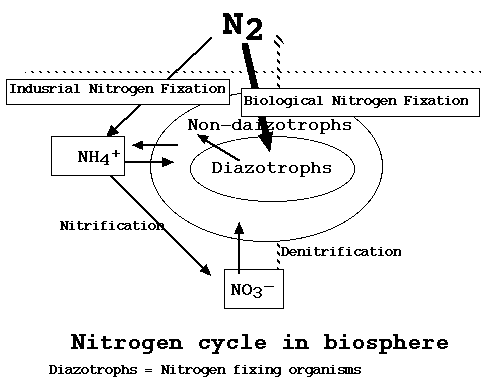Azotobacter: Difference between revisions
No edit summary |
(/* Genome Structure<br /> Azotobacters, interestingly, contain more DNA than most other bacteria, but their genome size is typical of most prokaryotes. The reason for this above average amount of DNA) |
||
| Line 28: | Line 28: | ||
<br />''Azotobacter'' is a genus of free-living diazotrophic bacteria whose resting stage is a cyst. It is primarily found in neutral to alkaline soils, in aquatic environments, and on some plants. It has several metabolic capabilties, including atmospheric nitrogen fixation by conversion to ammonia. Their unique system of three distinct nitrogenase enzymes makes these bacteria of particular interest to scientists, who may work toward a better understanding of nitrogen fixation and its role in agriculture. ''Azotobacter ''spp. have the highest metabolic rate of any organisms.<br /><br /> | <br />''Azotobacter'' is a genus of free-living diazotrophic bacteria whose resting stage is a cyst. It is primarily found in neutral to alkaline soils, in aquatic environments, and on some plants. It has several metabolic capabilties, including atmospheric nitrogen fixation by conversion to ammonia. Their unique system of three distinct nitrogenase enzymes makes these bacteria of particular interest to scientists, who may work toward a better understanding of nitrogen fixation and its role in agriculture. ''Azotobacter ''spp. have the highest metabolic rate of any organisms.<br /><br /> | ||
==Genome Structure<br /> Azotobacters, interestingly, contain more DNA than most other bacteria, but their genome size is typical of most prokaryotes. The reason for this above average amount of DNA is not known, but it is possibly because the cells of ''Azotobacter'' are larger than those of other bacteria. The DNA of ''Azotobacter'' spp. display many similarities, in terms of gene type and recognition factors, to the DNA of ''Escherichia coli''. Genetic information can be transferred between azotobacters or to other bacteria by way of conjugation or transformation. For NCBI's GenBank entry for ''Azotobacter'''s unfinished sequence, click [http://www.ncbi.nlm.nih.gov/genomes/framik.cgi?db=genome&gi=5124 here]. <br /><br /> | ==Genome Structure==<br /> Azotobacters, interestingly, contain more DNA than most other bacteria, but their genome size is typical of most prokaryotes. The reason for this above average amount of DNA is not known, but it is possibly because the cells of ''Azotobacter'' are larger than those of other bacteria. The DNA of ''Azotobacter'' spp. display many similarities, in terms of gene type and recognition factors, to the DNA of ''Escherichia coli''. Genetic information can be transferred between azotobacters or to other bacteria by way of conjugation or transformation. For NCBI's GenBank entry for ''Azotobacter'''s unfinished sequence, click [http://www.ncbi.nlm.nih.gov/genomes/framik.cgi?db=genome&gi=5124 here]. <br /><br /> | ||
==Cell Structure and Metabolism== | ==Cell Structure and Metabolism== | ||
Revision as of 12:57, 1 June 2006
|
|
|
ClassificationHigher order taxa:
Species:Azotobacter chroococcum Description and Significance
==Genome Structure== Cell Structure and Metabolism
EcologyDiazotrophic organisms such as Azotobacter play a vital role in every ecosystem, working to make nitrogen available to all organisms. Azotobacters and similar bacteria turn nitrogen into ammonia through the process of nitrogen fixation, after which the ammonia is turned into proteins. Nitrogen fixation is used in agriculture in relation to crop rotation and fertilization; soil-dwelling diazotrophs such as Azotobacter are especially useful in gauging the health and virility of the ground. Azotobacters are found worldwide, in climates ranging from extremely northern Siberia to Egypt and India. {| width="100%"
|
 Above are soil samples containing differing amounts of Azotobacter. The top left sample displays a healthy amount of Azotobacter, which decreases to moderate level in the top right and a poor level of Azotobacter in the bottom sample. Image from N.A. Krasil'nikov. |
References. Updated May 31, 2006
Azotobactercysts. The Microbe Zoo, Digital Learning Center for Microbial Ecology.
Azotobacter vinelandii.Molecular Microbiology Department, The John Innes Center.
Crum, Amy. Azotobacter: Soil Microbiology. Biology Department, Virginia Polytechnic Institute and State University.
Deacon, Jim. The Microbial World: The Nitrogen Cycle and Nitrogen Fixation. Institute of Cell and Molecular Biology, The University of Edinburgh.
JGI A. vinelandii Home. Eukaryotic Genomics, Doe Joint Genome Institute.
Krasil'nikov, N.A. Soil Microorganisms and Higher Plants. Academy of Sciences of the USSR Institute of Microbiology.
Watanabe, Iwao. Biological Nitrogen Fixation and its Use in Agriculture. Cantho University, Vietnam.


